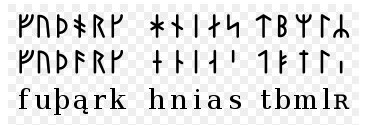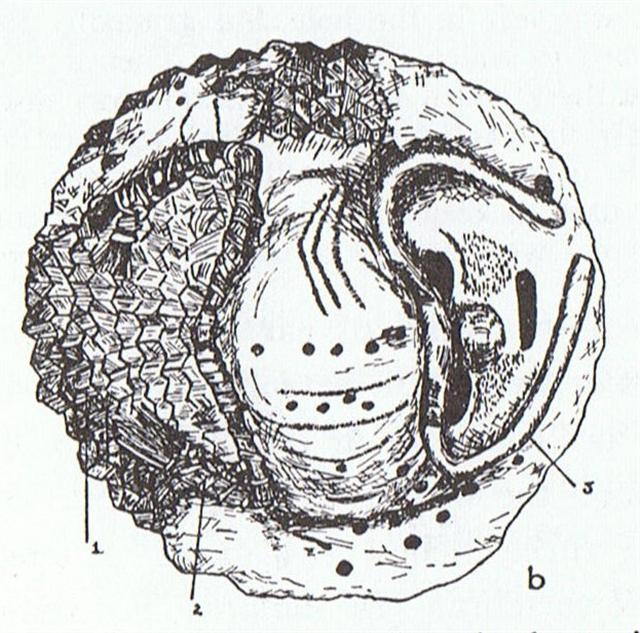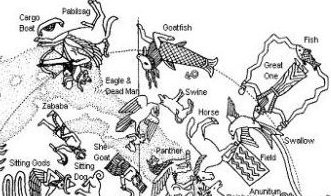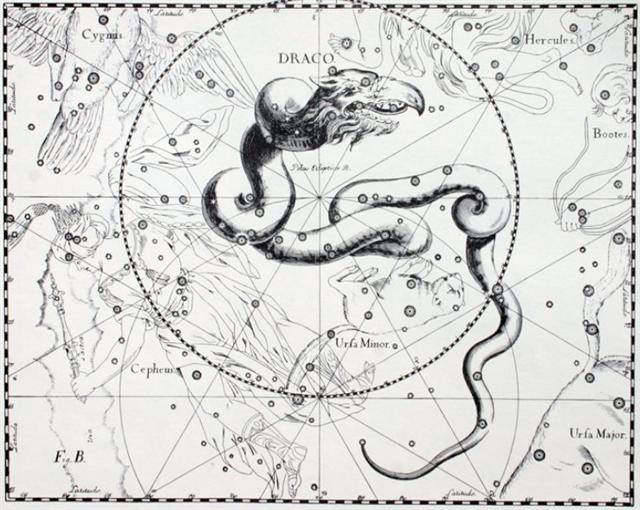I guess the strange place Pu Pakakina A Ira (not A Hau Maka), where the explorers stayed for a month, could have been a description of how their Sun calendar had to be changed. They surfed and behaved as turtles, as if trying to induce the Earth Turtle to come ashore, while Ira worked with his holes. The calendar from the time of Al Sharatain was no longer in contact properly with the Earth Turtle (7), whose upper shell (Ç ) may have 'personified' the high summer half of the year:
If 27 days had to be added to the Sun calendar of the explorers, then the heliacal stars would once again be synchronized with the calendar Turtle, with her position 'at the water line' (0h) after having deposited her offspring in the sandy bay at high tide:  The G text has 229 glyphs on side a and 1 + 229 - 62 = 168 = 7 * 24. Counting time in the night the 'zero night' had accumulated in full only at the end of the first night. Caesar had inserted 62 days (July and August) before September, the 7th month. Or the 8th month if also a 'zero month' was counted, in which case June would be the 7th month. However, in rongorongo times Sirius rose heliacally in June 30, with 6-30 alluding to RA day 63 at the end of side b of the G text. To add 27 days in the G text (as counted by pebbles or glyphs in broad daylight) would have resulted in 229 + 27 = 256 (= 8 * 32 = 8 * 21 + 8 * 11 = 168 + 88). This position is at the beginning of line b2. Possibly all would be in good order from there and forward in the text, having added not only Caesar's 62 days but also 27 days for the heliacal difference between 0h in rongorongo times and 0h in Caesar's time. Assuming the beginning of side a was at 0h as defined by when the Hyades door was at the northern spring equinox, then we can add 80 + 256 = 336 to find the modern date at the beginning of line b2. This will be December 2 - where 336 = 2 * 168. The 'bottom shell' (È) of the Earth Turtle could have begun there. Counting backwards from the beginning of line b2, i.e. by counting December 2 (336) - 26 (number of glyphs in line b1) = 310 (November 9), we will then find the first glyph on side b as number 310 - 80 = 230 (counted from the northern spring equinox but not including the day at 0h):
I decided from now on to let the RA days determine the calendar dates, for instance to determine ºJuly 7 from *111 - 4 = *107. Earlier I had counted the calendar dates running from the beginning, but complications of various kinds arose. The different sets of dates are all of them interesting and we cannot perceive any of them as definitely more relevant than the others. They may indeed once upon a time have been designed to be precisely so. The stars were not moving as all the rest and it was worth while to work hard with them. They stood firm and were seen flying from east to west only because earth rotated. ... The Scarab of Sun is rolling our Earth forward ('ahead'), a rounded ball filled with us living beings, we can imagine ...
Number 227 surely alludes to π and with this distance between tagata in Ga1-2 and the beginning of side b it implies a change from counting time in the night to 'counting pebbles in broad daylight', from counting 24 hours in a night cycle to counting 16 days until the heliacal star became visible, enhancing the importance of the Sun 'beetle'.
With one glyph per heliacal day it seems clear that the 'tail of the Eagle' (Deneb Okab) at Gb1-1 must have been a Sign:
I guess Aquila represented the old Sun transporting the new little one across dangerous waters. This idea may have been there already with the Babylonians, although they had a Dead Man captured in the claws of an Eagle:
... In late September or early October 130, Hadrian and his entourage, among them Antinous, assembled at Heliopolis to set sail upstream as part of a flotilla along the River Nile. The retinue included officials, the Prefect, army and naval commanders, as well as literary and scholarly figures. Possibly also joining them was Lucius Ceionius Commodus, a young aristocrat whom Antinous might have deemed a rival to Hadrian's affections. On their journey up the Nile, they stopped at Hermopolis Magna, the primary shrine to the god Thoth. It was shortly after this, in October [in the year A.D.] 130 - around the time of the festival of Osiris - that Antinous fell into the river and died, probably from drowning. Hadrian publicly announced his death, with gossip soon spreading throughout the Empire that Antinous had been intentionally killed. The nature of Antinous's death remains a mystery to this day, and it is possible that Hadrian himself never knew; however, various hypotheses have been put forward. One possibility is that he was murdered by a conspiracy at court. However, Lambert asserted that this was unlikely because it lacked any supporting historical evidence, and because Antinous himself seemingly exerted little influence over Hadrian, thus meaning that an assassination served little purpose. Another suggestion is that Antinous had died during a voluntary castration as part of an attempt to retain his youth and thus his sexual appeal to Hadrian. However, this is improbable because Hadrian deemed both castration and circumcision to be abominations and as Antinous was aged between 18 and 20 at the time of death, any such operation would have been ineffective. A third possibility is that the death was accidental, perhaps if Antinous was intoxicated. However, in the surviving evidence Hadrian does not describe the death as being an accident; Lambert thought that this was suspicious. Another possibility is that Antinous represented a voluntary human sacrifice. Our earliest surviving evidence for this comes from the writings of Dio Cassius, 80 years after the event, although it would later be repeated in many subsequent sources. In the second century Roman Empire, a belief that the death of one could rejuvenate the health of another was widespread, and Hadrian had been ill for many years; in this scenario, Antinous could have sacrificed himself in the belief that Hadrian would have recovered. Alternately, in Egyptian tradition it was held that sacrifices of boys to the Nile, particularly at the time of the October Osiris festival, would ensure that the River would flood to its full capacity and this fertilize the valley; this was made all the more urgent as the Nile's floods had been insufficient for full agricultural production in both 129 and 130. In this situation, Hadrian might not have revealed the cause of Antinous's death because he did not wish to appear either physically or politically weak. Conversely, opposing this possibility is the fact that Hadrian disliked human sacrifice and had strengthened laws against it in the Empire. Thoth, the Egyptian Moon good, had invented the letters of the alphabet and these implied watching the phases of the Moon, the first time giver known to all creatures. But when Thuban in Roman times had reached autumn equinox the star watchers suddenly changed their perspective to look for the stars at the opposite side of the sky, those rising with the Sun around the First Point of Aries: ... In Roman times Thuban (α Draconis) was close to the Full Moon at the northern spring equinox, whereas Hamal (α Arietis) was rising with the Sun. Early, when the Hyades rose heliacally, Thuban would have been at heliacal RA day 148, which meant rising with the Sun in day 80 + 148 = 228 (August 16). 22 * 8 (not division as in 22 / 7 but its opposite) = 176 which when counting also the zero night becomes 177 = 6 * 29½ ...
Alrisha (the Knot) was at the opposite side of the sky compared to Thuban:
With Polaris in the day before Sheratan we can guess day zero was at Polaris. Another day zero could then have been at Thuban. In rongorongo times this would have been in the day before 14h:
Cb1-4 could allude to 14h and counting from the zero day the reversed figure in Ga6-9 will be number 150:
According to Manuscript E the Sun king (Hotua Matua) arrived to Easter Island in Tagaroa Uri 15, a date which seems to refer to the date ºOctober 15, when the pope Gregorius XIII had the tail of Draco (Thuban) rising with the Sun.
But in rongorongo times Thuban had moved ahead 4 days and therefore the correct Sun calendar should have Tagaroa Uri 15 at an earlier place in the cosmic geography, viz. at Nga Kope Ririva A Taanga - the 3 islets outside the island proper:
When the time was right the eye of the astronomer quickly followed in the path of least resistance across the sky from one equinox to the other, leaving Thuban outside the system for good.
| |||||||||||||||||||||||||||||||||||||||||||||||||||||||||||||||||||||||||||||||||||||||||||||||||||||||||||||||||||||||||||||||||||||||||||||||||||||||||||||||||||||||||||||||||||||||||||||||||||||||||||||||||||||||||||||||||||||||||||||||||||||||||||||||||||||||||||||||||||||||||||||||||





















